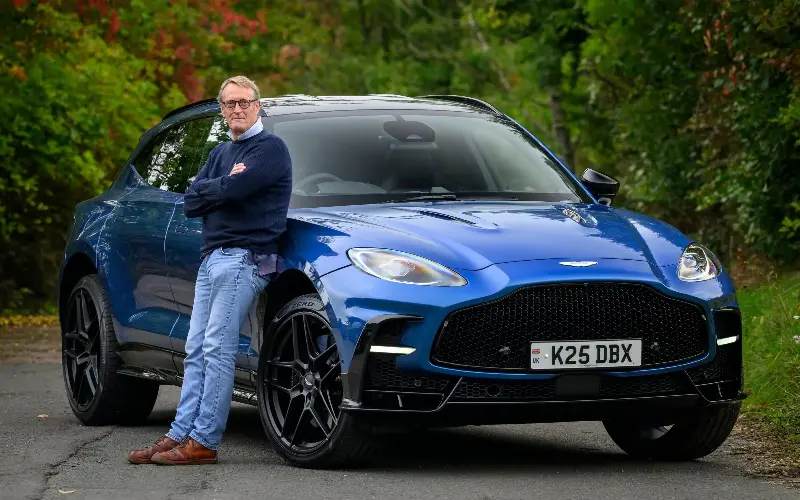
How did the Super Sports Utility Vehicle evolve? Certainly, the first Range Rover of 1970 was pretty super; a two-tonne, luxury go-anywhere 4x4 with a 3.5-litre V8 engine, a top speed of about 100mph and 0-62mph acceleration in less than 14sec. “A car for all reasons,” touted the adverts. It seemed otherworldly at the time.
It took a while for rivals to catch up, arguably the Lamborghini LM002 of 1977 moved the idea on, then the first Porsche Cayenne in 2003. But now we’re buried in the things: the BMW X7; Mercedes-Benz GLS; Audi Q8; Bentley Bentayga; Rolls-Royce Cullinan; Ferrari Purosangue and Lamborghini’s return to form with the 2018 Urus.
Easy targets for derision, enhanced taxes and parking fees, the super SUV is also pretty good to drive – and the super-wealthy love them. Few could blame Aston Martin for joining the market in 2020 with the DBX, which brought a degree of sober style and comfort as well as mighty performance to the genre. Not that the first quality seemed particularly valued by buyers; in the world of super SUVs, more is most definitely more.
Power play
The uprated DBX 707 of 2022 squeezed the original DBX’s Mercedes-AMG 4.0-litre V8 engine to deliver the eponymous 707PS (697bhp) but you need to give the super SUV buyer another reason to splash out and this is it: the DBX S.
At £210,000 against the 707’s £190,000, you’d expect there to be a fair bit more underneath the striking Plasma Blue bodywork. Sure enough, there’s another 20bhp thanks to the use of larger turbine wheels for the turbochargers courtesy of the Valhalla supercar project.
The 717bhp/664lb-ft Mercedes-AMG engine is mated to the same company’s nine-speed automatic gearbox using a wet-clutch system in place of a traditional torque converter, for better handling and control of the engine’s output. There’s drive to the front wheels via a shaft travelling through the sump and to the rears via an electronic limited-slip differential.
Lightweight extras
It’s also lighter, with several “lightweight extras” which reduce the kerb weight by 47kg to 2,198kg. Yet the performance is almost the same as the outgoing 707; 193mph, 0-62mph in 3.3sec and almost the same 19.8mpg WLTP fuel economy. Only the 0-124mph acceleration time falls, by 0.3sec.
Your 20 grand also buys a new grille and, in the case of our test car, optional and fabulously spindly 23-inch matt-black wheels; kerbing them looks ruinously expensive. Aston is coy about the exact cost of the lightweight extras although the carbon-fibre roof, which saves 18kg, is an extra £5,000 and the magnesium alloy wheels £15,000.
Inside, the touchscreen system finally gets with the 21st century so it’s larger, more reactive and clearer thanks to better graphics. There’s still a confusion factor in it, while I never quite managed to hook up my Waze routefinder with the unit (but that might be my problem rather than the car’s). And in keeping with modern EU diktats, there’s the always-on lane-keeping and speed-limit warning chimes, although Aston has thoughtfully provided a button with which to switch them off.
With carbon-fibre and piano black trim panels liberally used inside, there’s an aura of clackety high tech, although such trim finishes are easily marked. Leather, Alcantara and various wood veneers are alternative options.
The front seats are comfortable but hold you tightly; for some folk they could verge on pinchy. The driving position is good and with quarter-light front windows outward vision is good in tight spaces; an array of parking and photographic sensors help to get the thing parked, while the door mirrors are large and well sited.
In the back there’s leg and head room enough for three adults and the seat backs fold to give an almost flat load bed. Luggage space is 638 litres plus 81 under the floor and a spacesaver spare wheel costs £475 extra. The DBX S will tow up to 2.7 tonnes and wade in up to half a metre of water.
Great ride
The three-chamber air suspension on the wishbone front and multi-link rear suspension copes brilliantly (a lot of systems have low-speed ride issues), especially considering the tyres have barely any cushioning sidewall.
Equally the 48-volt active anti-roll bars don’t transfer bumps across the car when traversing broken-edged roads, at least in the softest GT driving mode. However, you need to look down at the centre console to select settings for the suspension and drivetrain, exhaust noise and so on. It’s a good system, but the camera sentinels are likely to admonish you to keep your eyes on the road.
The Sport mode lowers the body by 50mm and gives the DBX a more balanced feel, the ride still absurdly good for such a large and heavy car. And the steering is just-so: well weighted, progressive and linear in its reaction.
Speeding up
When first using more than an inch of the accelerator pedal’s travel, your reaction is one of shock. In GT mode it takes the gearbox a second to catch up with your intentions (you can always change down with the steering-wheel paddles), but in Sport or Sport + the reaction is electric.
It’s simply hard to believe that such a large car can behave like this. It might feel slightly artificial but the air suspension and anti-roll systems do an amazing job of making the DBX S feel much smaller, lighter and wieldier than it has any right to. If you’ve any doubts about how fast it feels, dial in the launch control and basically leave your stomach behind as you cling on, your head spinning.
Fortunately, the brakes are as brilliant as the chassis with carbon-ceramic discs and six-piston calipers at the front; there’s a lovely progression to how the DBX slows and stops.
The Telegraph verdict
This must be the fastest point-to-point car Aston Martin has produced, and the way it can be driven briskly along some of the worst-maintained roads is simply breathtaking.
If you are in the mood it can feel (almost) like a sports coupé, although in the end the weight will dominate and on fast, tightening bends the front likes to drive straight on.
In modern sensibilities this is the ultimate GT; fast, smooth, comfortable and luxurious. No wonder people hate them; they’ll say it’s about space and the environment, but I can’t help wondering if it’s partly envy.
The facts
On test: Aston Martin DBX S
Body style: performance SUV
On sale: now, first deliveries this autumn
How much? from £210,000 OTR
How fast? 193mph, 0-62mph in 3.3sec
How economical? 19.8mpg (WLTP Combined), 18.7mpg on test
Engine & gearbox: 4.0-litre four-camshaft twin-turbo petrol V8, nine-speed automatic transmission and multi-plate wet clutch, four-wheel drive with electronic rear limited-slip differential
Maximum power/torque: 717bhp @ 6,250rpm, 664lb ft @ 3,000 to 5,250rpm
CO2 emissions: 323g/km (WLTP Combined)
VED: £5,490 first year, £620 next five years, then £195
Warranty: 3 years/unlimited mileage
The rivals
Lamborghini Urus, from £208,000
A 4.0-litre V8 with a hybrid drivetrain (essentially the same as the Audi RS Q8 and the Porsche Cayenne) means the Italian now musters 789bhp. Top speed is 194mph with 0-62mph in 3.4sec, but the 26kWh battery and hybrid drivetrain raises the kerb weight above 2.5 tonnes. Feels a bit artificial and contrived, but thuggishly effective.
Porsche Cayenne Turbo E-Hybrid Coupé with GT Package, from £166,100
Stuttgart’s riposte to the sister Lamborghini. Its twin-turbo V8 hybrid has a little less power and torque; the top speed is 190mph, with 0-62mph in 3.6sec. It is a neater package than the Aston and the hybrid system means the fuel consumption is a bit less wallet-wilting as well.
